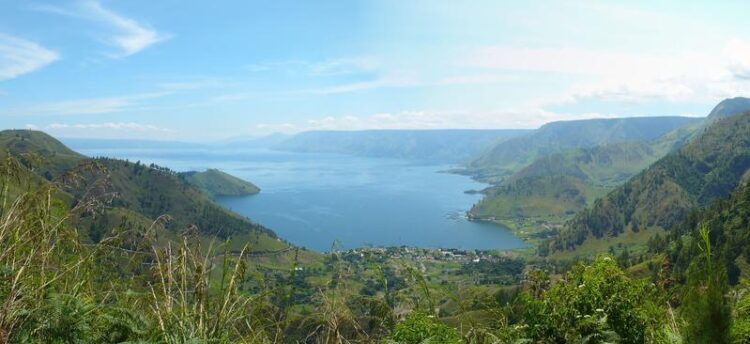Nightmare Without End

Partial view of the Toba Lake in Sumatra (Indonesia). This lake fills a volcanic collapse structure left behind after a huge explosion 75,000 years ago.
(c) Adonara Mucek
Study with participation from Heidelberg shows that supervolcanoes remain dangerous long after erupting.
Besides cosmic impacts, supervolcanic eruptions rank among the worst catastrophes in the Earth’s history, like that of the Toba volcano on Sumatra (Indonesia) approximately 75,000 years ago, which affected all of Southeast Asia and beyond. Eruptions of a similar magnitude are known worldwide only from Yellowstone (USA) and a few other volcanoes that were active within the current geological period of the Quaternary. Until now, scientists assumed that the biosphere recovered from the impact of such supereruptions in decades to centuries. Using the Toba volcano as an example, an international research team that includes Prof. Dr Axel Schmitt from the Institute of Earth Sciences of Heidelberg University recently demonstrated that supervolcanoes remain active and dangerous for thousands of years after they erupt.
Supervolcanic eruptions vent vast amounts of magma at the Earth’s surface, cracking the Earth’s crust above the evacuating magma chamber and leaving behind a depression known as a caldera that often fills with water. In the case of the Toba volcano, the caldera lake is about 100 km long, 30 km wide, and up to 500 m deep. “Its size corroborates the horrific destructive power of these types of volcanic eruptions,” explains Prof. Schmitt, who heads the research group for Isotope Geology and Petrology at the Institute of Earth Sciences. “The release of volcanic dust and gases can also change the Earth’s climate, triggering a so-called volcanic winter accompanied by widespread food shortages and mass die-offs.” Volcano research therefore focuses on when and how the massive quantities of magma vented in a supereruption accumulated, and in what form the magma existed before and after an explosion.
To explore these questions, the researchers investigated the minerals feldspar and zircon in lava rock that erupted inside the caldera after the Toba supereruption. Based on radiometric dating with the Heidelberg ion probe, an ultra-high-resolution mass spectrometer, they were able to determine the age of zircon crystals in the rock. According to these and other analyses, the Toba volcano remained active for 5,000 to 13,000 years after its eruption, making it dangerous at least to its immediate environment. Additional measurements indicated that the magma erupted at the surface in a comparatively cold and nearly solid, rock-like state. The researchers report that this phenomenon is often observed in craters of stratovolcanoes, although never at this size. “After the Toba eruption, the solidified carapace of the residual magma was domed up like a turtle shell,” says Axel Schmitt, describing the newly discovered process.
“We have to adjust our understanding of volcanoes in this regard,” stresses Prof. Dr Shanaka de Silva of Oregon State University (USA), recipient of a Humboldt Research Award for internationally leading researchers currently working at Heidelberg University. “To predict a volcanic eruption, we normally attempt to determine if molten rock has accumulated in the subsurface using geophysical methods. Our study shows that volcanoes can also erupt when magma immediately under the volcano has solidified. That means we have to adjust our monitoring and early warning systems for active volcanoes as well as evaluate their risk potential differently.”
In addition to Axel Schmitt of Heidelberg University and Shanaka de Silva, several other researchers from Oregon State University as well as from Curtin University (Australia) and the Geological Agency of Indonesia contributed to the study. The research results were published in the Nature journal “Communications Earth & Environment”. The National Science Foundation, the Geological Society of America, the Australian Research Council, and the German Research Foundation provided the funding for the work, among others.
Contact:
Heidelberg University
Communications and Marketing
Press Office, phone +49 6221 54-2311
presse@rektorat.uni-heidelberg.de
Wissenschaftliche Ansprechpartner:
Prof. Dr Axel Schmitt
Institute of Earth Sciences
Phone +49 6221 54-8206
axel.schmitt@geow.uni-heidelberg.de
Originalpublikation:
A.E. Mucek, M. Danisik, S.L. de Silva, D.P. Miggins, A.K. Schmitt, I. Pratomo, A. Koppers, J. Gillespie: Resurgence initiation and subsolidus eruption of cold carapace of warm magma at Toba Caldera, Sumatra. Communications Earth & Environment (3 September 2021), https://doi.org/10.1038/s43247-021-00260-1
Weitere Informationen:
http://www.geow.uni-heidelberg.de/forschungsgruppen/schmitt/schmitt.html
Media Contact
All latest news from the category: Earth Sciences
Earth Sciences (also referred to as Geosciences), which deals with basic issues surrounding our planet, plays a vital role in the area of energy and raw materials supply.
Earth Sciences comprises subjects such as geology, geography, geological informatics, paleontology, mineralogy, petrography, crystallography, geophysics, geodesy, glaciology, cartography, photogrammetry, meteorology and seismology, early-warning systems, earthquake research and polar research.
Newest articles

Skyrmions move at record speeds
… a step towards the computing of the future. An international research team led by scientists from the CNRS1 has discovered that the magnetic nanobubbles2 known as skyrmions can be…

A flexible and efficient DC power converter for sustainable-energy microgrids
A new DC-DC power converter is superior to previous designs and paves the way for more efficient, reliable and sustainable energy storage and conversion solutions. The Kobe University development can…

Technical Trials for Easing the (Cosmological) Tension
A new study sorts through models attempting to solve one of the major challenges of contemporary cosmic science, the measurement of its expansion. Thanks to the dizzying growth of cosmic…




















